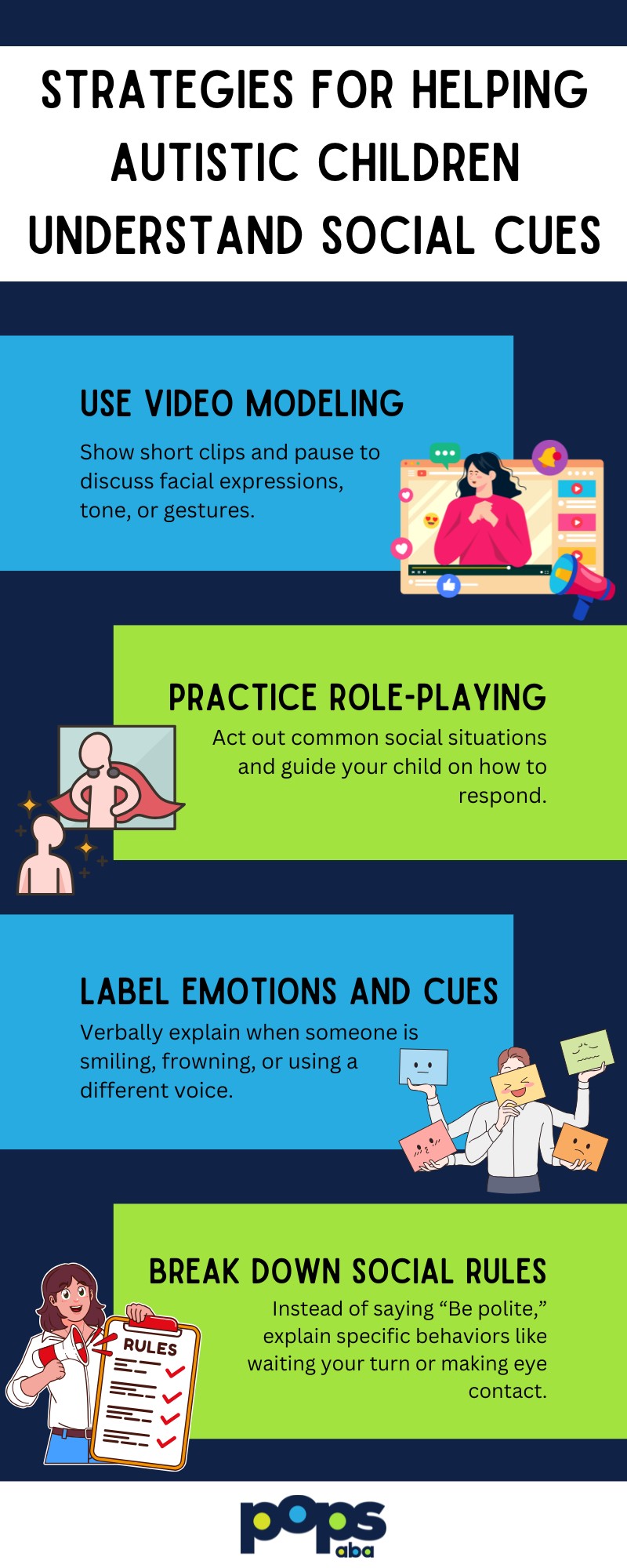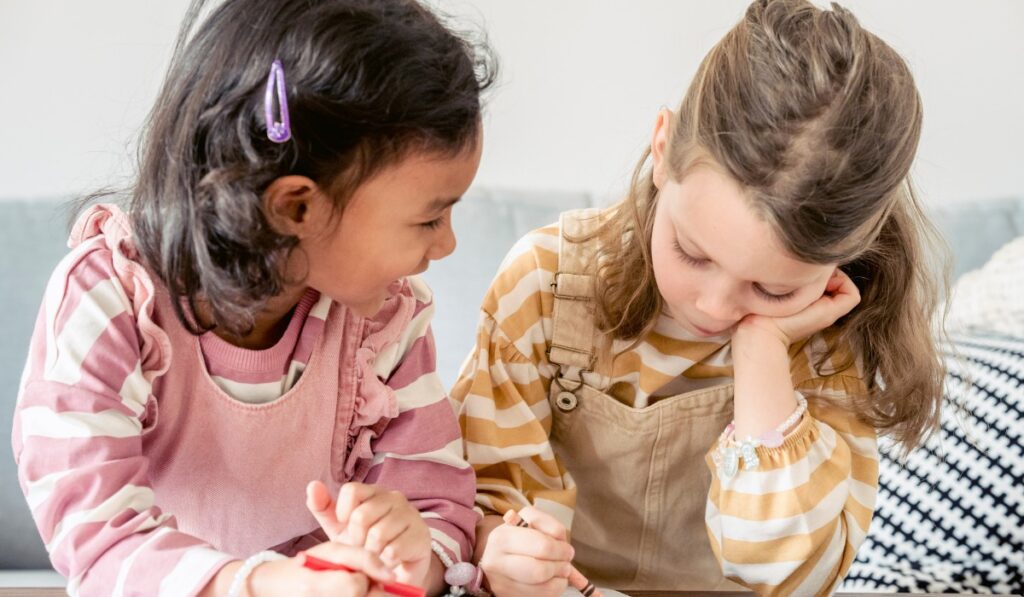Key Points:
- Children with autism often have difficulty interpreting facial expressions, tone of voice, and body language.
- Social cue deficits can impact friendships, classroom dynamics, and family relationships.
- Practical strategies like modeling, prompting, and ABA therapy can help improve social awareness and communication.
Social interactions are a crucial part of daily life, but for children with autism, navigating these interactions can feel confusing and overwhelming. One of the core challenges is interpreting social cues—nonverbal and verbal signals like facial expressions, gestures, tone of voice, and eye contact.
These cues help most people understand what others are thinking or feeling, but for children on the spectrum, they may be difficult to recognize or respond to appropriately. Parents often observe that their child may not notice when someone is bored, frustrated, or trying to join a conversation.
In this article, we’ll go over what social cues are, how autism affects their interpretation, examples of these challenges, and what can be done to support children in better understanding social information.
What are Social Cues in Autism?
Social cues in autism refer to difficulties in recognizing and interpreting nonverbal signals like facial expressions, tone of voice, body language, and eye contact. These challenges can make social interactions confusing and may lead to misunderstandings, isolation, or frustration.
Children with autism might not pick up on subtle emotional signs. They may misinterpret sarcasm as literal, ignore someone’s body language indicating discomfort, or fail to notice that they’ve interrupted a conversation.
These behaviors are not intentional but stem from neurological differences in how social information is processed. Understanding this is key for building effective supports.
Why Do Children with Autism Struggle with Social Cues?
Children with autism experience differences in how their brains process social information. This affects both how they read social cues and how they respond to them. Social communication is a multi-step process: observing, interpreting, and reacting to another person’s signals. At any of these steps, a breakdown may occur.
One reason is that autistic children often have differences in joint attention, or the shared focus between two people. They may also have reduced sensitivity to facial expressions and tone of voice. Additionally, if a child struggles with theory of mind (the ability to understand that others have thoughts and feelings different from their own), they may not understand the intent behind someone’s gestures or expressions.
What are Some Common Examples of Social Cue Difficulties?
Children with autism may miss or misunderstand a wide range of social signals. This can make everyday social situations—like playing with peers, attending school, or even talking with family—feel challenging or unpredictable.
Here are several examples of how social cue difficulties can show up in real life:
Lack of Eye Contact
Children may avoid or forget to make eye contact, which can affect how others perceive their engagement or interest.
Misinterpreting Facial Expressions
They might not recognize or respond to facial cues like frowns, smiles, or raised eyebrows, impacting emotional understanding.
Ignoring Tone of Voice
Difficulty picking up on voice inflections can cause confusion about someone’s mood, intentions, or whether they’re joking or serious.
Standing Too Close or Too Far
Challenges with spatial awareness may lead to discomfort in social settings due to invading or avoiding personal space boundaries.
Failing to Take Turns in Conversation
They may interrupt, dominate, or withdraw from conversations, missing key moments to engage or respond appropriately.
Missing Indirect Cues
Subtle signals like glancing at a clock or turning away may go unnoticed, leading to awkward or prolonged interactions.
Literal Interpretation of Language
Idioms, jokes, or sarcasm may confuse them, resulting in misunderstandings or seemingly odd responses during conversations.
Inappropriate Laughter or Silence
They might laugh during serious moments or stay silent when celebration is expected, due to difficulty matching emotional responses.
Each of these behaviors can lead to social friction, making it harder for the child to build friendships or feel included in group settings.

How Social Cue Misunderstandings Affect Daily Life
When a child can’t accurately read or respond to social cues, it can cause problems across various settings—home, school, and public environments. These difficulties aren’t just awkward moments; they can deeply impact a child’s emotional well-being and social development.
At school, children who don’t pick up on classroom norms may be labeled disruptive or inattentive. On the playground, they might be excluded for seeming “weird” or “rude.” At home, parents may feel frustrated if their child doesn’t seem to understand boundaries or family dynamics.
Common consequences of social cue misunderstandings include:
Social Isolation
Misreading cues can make peer interactions awkward, leading classmates to exclude the child from group activities or friendships.
Emotional Frustration
Children may become upset or anxious when they sense rejection but can’t identify the social reasons behind it.
Behavioral Issues
Frustration from misunderstood cues can result in meltdowns, shutdowns, or acting out in social or academic environments.
Academic Challenges
Children might misinterpret instructions or feedback, struggle with group work, or appear inattentive due to missed social context.
Family Conflict
Misunderstandings around tone, boundaries, or routines may lead to tension between the child and family members, especially siblings.
Recognizing these ripple effects is crucial for understanding why social communication support is so important.
How Can Parents Help Their Child Understand Social Cues?
While the challenges are real, there are many effective ways parents can help their child improve social awareness. Learning to recognize and respond to social cues takes time and repetition, but small, consistent efforts can make a big difference.
One of the best tools parents have is modeling—demonstrating the behavior you want your child to imitate. For example, you can exaggerate facial expressions while talking or pause to explain what a certain tone of voice means. Using real-life moments to teach these concepts helps children apply what they learn in natural settings.
Practical strategies for parents include:

Integrating these practices into daily routines can lead to steady improvement over time.
How Does ABA Therapy Support Social Cue Development?
Applied Behavior Analysis (ABA) is one of the most evidence-based interventions for autism, particularly in teaching social and communication skills. ABA therapy breaks complex behaviors into smaller steps, making them easier to teach and reinforce. For social cues, this approach can be especially effective.
In ABA therapy, social skills are taught explicitly and systematically. Therapists may use structured lessons, role-play, games, and real-life practice to help children learn what different cues mean and how to respond appropriately. Progress is measured closely, and techniques are adapted based on how the child learns best.
This individualized, goal-oriented approach is ideal for children who need more structured help in navigating social environments.
Can Social Cue Awareness Improve Over Time?
Yes—social awareness can improve significantly with targeted support and practice. Children with autism do not lack the desire to connect; many simply need more help understanding how to do it. With the right tools and consistency, they can build skills that improve relationships, self-esteem, and quality of life.
Progress varies by individual, but many children show noticeable gains with early intervention. It’s important for parents to remain patient, celebrate small wins, and stay involved in the learning process. Teaching social understanding isn’t a one-time event—it’s a gradual journey.
Turn Challenges Into Learning With ABA Therapy
At Pops ABA, we specialize in helping children with autism strengthen social communication through personalized ABA therapy programs. Whether your child struggles with reading facial expressions, understanding tone of voice, or maintaining conversations, our team is here to guide that growth in a structured and supportive way.
Our ABA therapy in North Carolina and New Jersey focuses on real-world social skill development, using proven strategies that help children connect, express themselves, and navigate the world more confidently.
Get in touch with us today to learn how our ABA therapy programs can support your child’s social growth and help them thrive in every setting.



